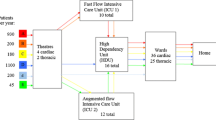Abstract
In this paper we strategically evaluate the efficiency of clinical pathways and their complex interdependencies with respect to joint resource usage and patient throughput. We propose a discrete-event simulation approach that allows for the simultaneous evaluation of multiple clinical pathways and the inherent uncertainty (resource, duration and arrival) that accompanies medical processes. Both the consultation suite and the surgery suite may be modeled and examined in detail by means of sensitivity or scenario analyses. Since each medical facility can somehow be represented as a combination of clinical pathways, i.e. they are conceptually similar, the simulation model is generic in nature. Next to the formulation of the model, we illustrate its applicability by means of a case study that was conducted in a Belgian hospital.





Similar content being viewed by others
References
Banks, J., Carson, J., Nelson, B., Nicol, D. (2001). Discrete-event system simulation. Upper Saddle River, NJ: Prentice Hall.
Beliën, J., Demeulemeester, E., Cardoen, B. (2006). Visualizing the demand for various resources as a function of the master surgery schedule: A case study. Journal of Medical Systems, 30, 343–350.
Blaser, R., Schnabel, M., Biber, C., Bäumlein, M., Heger, O., Beyer, M., et al. (2007). Improving pathway compliance and clinician performance by using information technology. International Journal of Medical Informatics, 76, 151–156.
Bowers, J., Mould, G. (2005). Ambulatory care and orthopaedic capacity planning. Health Care Management Science, 8, 41–47.
Cardoen, B., Demeulemeester, E. (2007). Evaluating the capacity of clinical pathways through discrete-event simulation, Research report KBI 0712, Katholieke Universiteit Leuven, Faculty of Business and Economics.
Cayirli, T., Veral, E. (2003). Outpatient scheduling in health care: A review of literature. Production and Operations Management, 12, 519–549.
De Bleser, L., Depreitere, R., De Waele, K., Vanhaecht, K., Vlayen, J., Sermeus, W. (2006). Defining pathways. Journal of Nursing Management, 14, 553–563.
Harper, P. (2002). A framework for operational modelling of hospital resources. Health Care Management Science, 5, 165–173.
Harper, P., Gamlin, H. (2003). Reduced outpatient waiting times with improved appointment scheduling: A simulation approach. OR Spectrum, 25, 207–222.
Jun, J., Jacobson, S., Swisher, S. (1999). Application of discrete-event simulation in health care clinics: A survey. Journal of the Operational Research Society, 50, 109–123.
Kelton, W., Sadowski, R., Sturrock, D. (2004). Simulation with arena. New York: McGraw-Hill.
Klassen, K., Rohleder, T. (1996). Scheduling outpatient appointments in a dynamic environment. Journal of Operations Management, 14, 83–101.
Panella, M., Marchisio, S., Di Stanislao, F. (2003). Reducing clinical variations with clinical pathways: Do pathways work? International Journal for Quality in Health Care, 15, 509–521.
Rohleder, T., Klassen, K. (2000). Using client-variance information to improve dynamic appointment scheduling performance. Omega—The International Journal of Management Science, 28, 293–302.
Su, S., Shih, C.-L. (2003). Managing a mixed-registration-type appointment system in outpatient clinics. International Journal of Medical Informatics, 70, 31–40.
Swisher, J., Jacobson, S., Jun, J., Balci, O. (2001). Modeling and analyzing a physician clinic environment using discrete-event (visual) simulation. Computers & Operations Research, 28, 105–125.
Vissers, J., Adan, I., Dellaert, N. (2007). Developing a platform for comparison of hospital admission systems: An illustration. European Journal of Operational Research, 180, 1290–1301.
Yeung, R., Leung, G., McGhee, S., Johnston, J. (2004). Waiting time and doctor shopping in a mixed medical economy. Health Economics, 13, 1137–1144.
Zander, K. (2002). Integrated care pathways: Eleven international trends. Journal of Integrated Care Pathways, 6, 101–107.
Acknowledgements
We would like to thank Prof. Dr. Walter Sermeus of the Center for Health Services and Nursing Research of the Katholieke Universiteit Leuven for introducing the concept of clinical pathways to our research group. We are grateful to Dr. Karl Brabants and Wim Van de Waeter of the Middelheim hospital in Antwerp, both for contributing their clinical experience when the model was built and for providing the data for the case study. We appreciate the contribution of Lode Van Damme to the revision and the testing of the simulation model. We acknowledge the support given to this project by the Bijzonder Onderzoeksfonds of the Katholieke Universiteit Leuven and the Fonds voor Wetenschappelijk Onderzoek (FWO-Vlaanderen) as Aspirant.
Author information
Authors and Affiliations
Corresponding author
Rights and permissions
About this article
Cite this article
Cardoen, B., Demeulemeester, E. Capacity of Clinical Pathways—A Strategic Multi-level Evaluation Tool. J Med Syst 32, 443–452 (2008). https://doi.org/10.1007/s10916-008-9150-z
Received:
Accepted:
Published:
Issue Date:
DOI: https://doi.org/10.1007/s10916-008-9150-z




